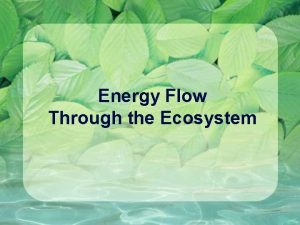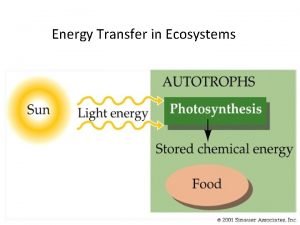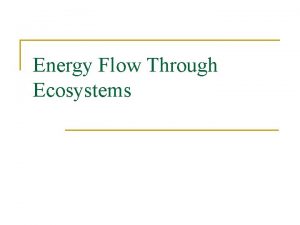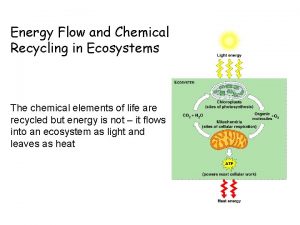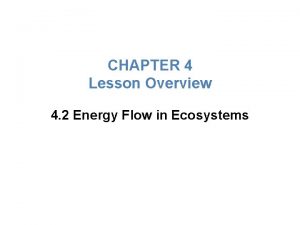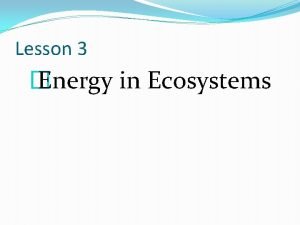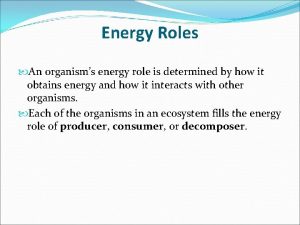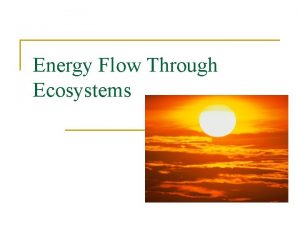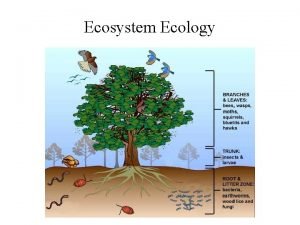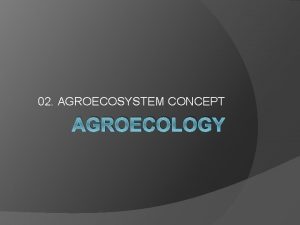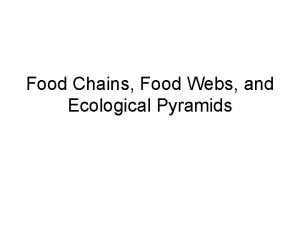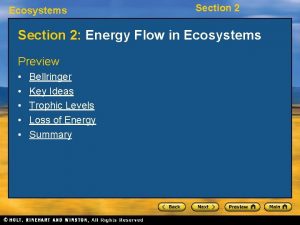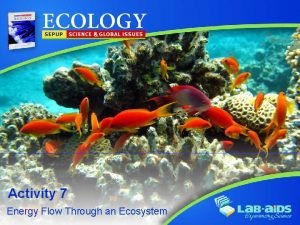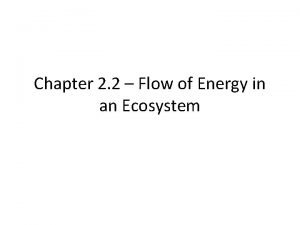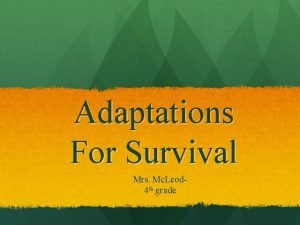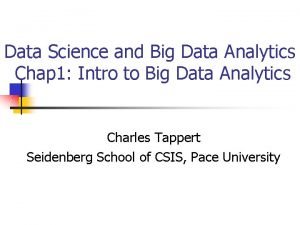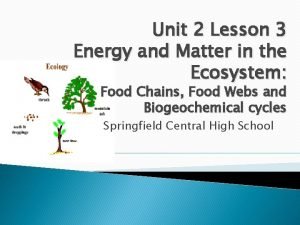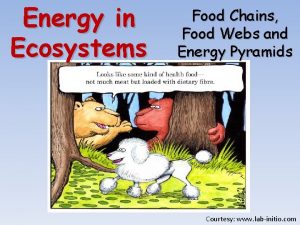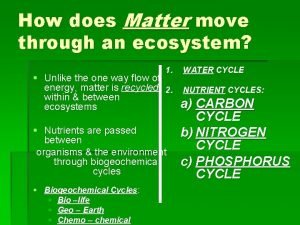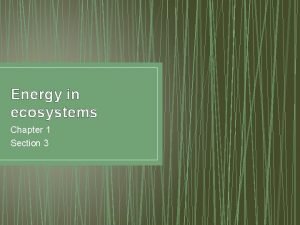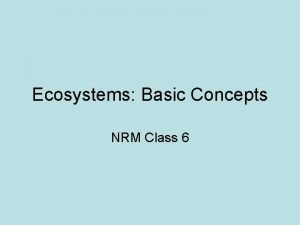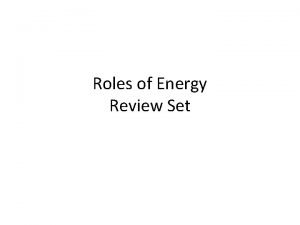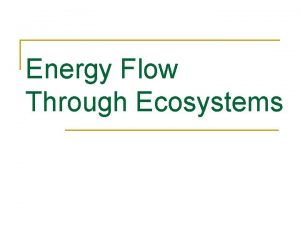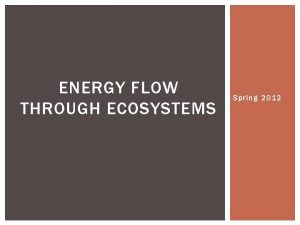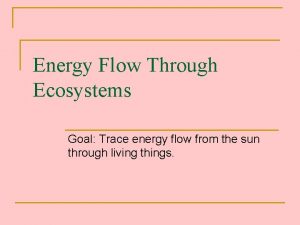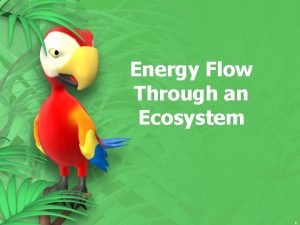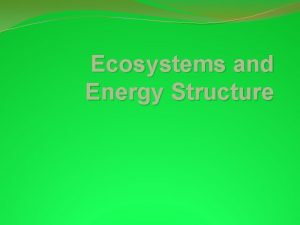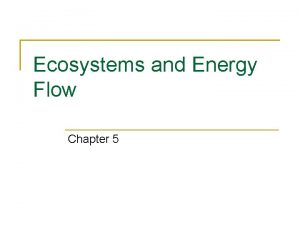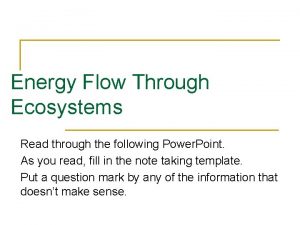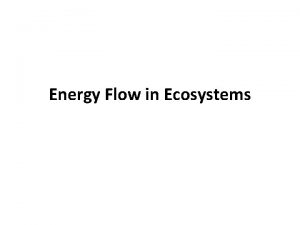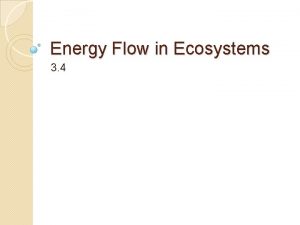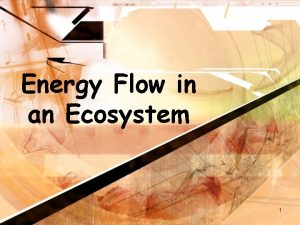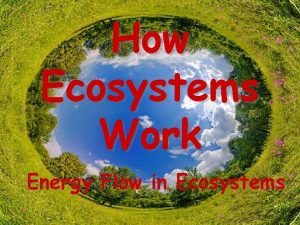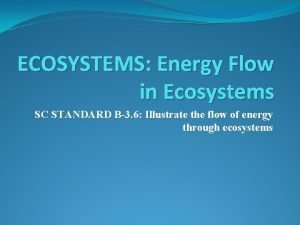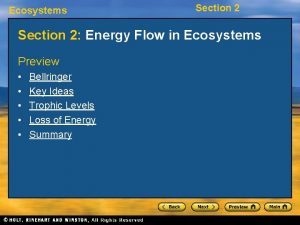Energy Flow Through Ecosystems Ecosystem and Energy Roles


































- Slides: 34

Energy Flow Through Ecosystems

Ecosystem and Energy Roles n n Ecosystem: all living & non-living things that interact in an environment Energy Role in an Ecosystem q Determined by: n n How it obtains energy How it interacts with other living organisms in its ecosystem

Some Energy Roles n n The sun: provides energy Producers: harness energy from the sun q n Consumers: organisms that eat something else q n ex. plants ex. animals Decomposers: return energy to the environment q ex. fungus, bacteria

Some Energy Roles n n The sun: provides energy Producers: harness energy from the sun q ex. Plants




Some Energy Roles n n The sun: provides energy Producers: harness energy from the sun q n ex. plants Consumers: organisms that eat something else q ex. animals




Some Energy Roles n n The sun: provides energy Producers: harness energy from the sun q n Consumers: organisms that eat something else q n ex. plants ex. animals Decomposers: return energy to the environment q ex. fungus, bacteria




Producers n n Plants harness energy from the sun through photosynthesis They are the base of every food chain q Source of food for all other animals

Consumers n 4 Types q Herbivore: eats only plants



Consumers n 4 Types q Herbivore: eats only plants q Carnivore: eats only meat



Consumers n 4 Types q Herbivore: eats only plants q Carnivore: eats only meat q Onmivore: eats plants and animals



Consumers n 4 Types q Herbivore: eats only plants q Carnivore: eats only meat q Onmivore: eats plants and animals q Scavenger: carnivore that feeds on bodies of dead organisms


Decomposer n Decomposers break down wastes and dead organisms and return the raw materials to the environment q Ex. Bacteria, fungi

Energy flow through biological systems

Food Chains n Food Chain: series of events in which one organism eats another and obtains energy

Food Chains Continued n n n Arrows always points in the direction of energy flow 1 st organism is always the producer 2 nd organism is the consumer that eats the producer q n 3 rd organism is the consumer that eats the 1 st level consumer q n Primary consumer Secondary consumer And so on…. .

Energy Pyramid n 2 nd Law of Thermodynamics: energy is not transferred from one object/organism to the next with 100% efficiency q n Some of the energy is lost to the environment Energy Pyramid shows the amounts of energy that moves from one level to the next

Sample Energy Pyramid

Energy Transfer n n Only about 10% of energy is transferred from one level to the next The other 90% is used by the organism to carry out its life processes or it is lost to the environment
 How does energy flow through the ecosystem
How does energy flow through the ecosystem Energy flow through an ecosystem is ----- *
Energy flow through an ecosystem is ----- * Energy flow through an ecosystem
Energy flow through an ecosystem How does energy flow through an ecosystem
How does energy flow through an ecosystem Flow of energy
Flow of energy Do birds eat squirrels
Do birds eat squirrels Chapter 4 lesson 2 energy flow in ecosystems answer key
Chapter 4 lesson 2 energy flow in ecosystems answer key Which marine ecosystem contains the fewest producers
Which marine ecosystem contains the fewest producers Primary consumers
Primary consumers Section 1 energy flow in ecosystems
Section 1 energy flow in ecosystems An organism's energy role is determined by how it obtains
An organism's energy role is determined by how it obtains What are the energy roles in an ecosystem
What are the energy roles in an ecosystem Energy flow and material cycling in ecosystem
Energy flow and material cycling in ecosystem Energy flow and material cycling in ecosystem
Energy flow and material cycling in ecosystem Biomass pyramid
Biomass pyramid Chapter 2 section 2 flow of energy in an ecosystem
Chapter 2 section 2 flow of energy in an ecosystem Energy flow in ecosystem
Energy flow in ecosystem Describe the flow of energy in the kelp forest ecosystem
Describe the flow of energy in the kelp forest ecosystem Principles of ecology 2 flow of energy in an ecosystem
Principles of ecology 2 flow of energy in an ecosystem Energy flow trophic levels
Energy flow trophic levels What roles do the musk ox play in the tundra ecosystem
What roles do the musk ox play in the tundra ecosystem Current analytical architecture
Current analytical architecture Chapter 42 ecosystems and energy
Chapter 42 ecosystems and energy Phosphorus cycle
Phosphorus cycle Lab food chains and energy in ecosystems
Lab food chains and energy in ecosystems Flow energy review
Flow energy review Oikos meaning
Oikos meaning How does matter move
How does matter move Section 3 energy in ecosystems
Section 3 energy in ecosystems Ecosystem definition class 6
Ecosystem definition class 6 Tangential sawing advantages and disadvantages
Tangential sawing advantages and disadvantages By one man sin
By one man sin Dome of furcation
Dome of furcation The night of the scorpion
The night of the scorpion What ecological role best describes grizzly bears?
What ecological role best describes grizzly bears?
